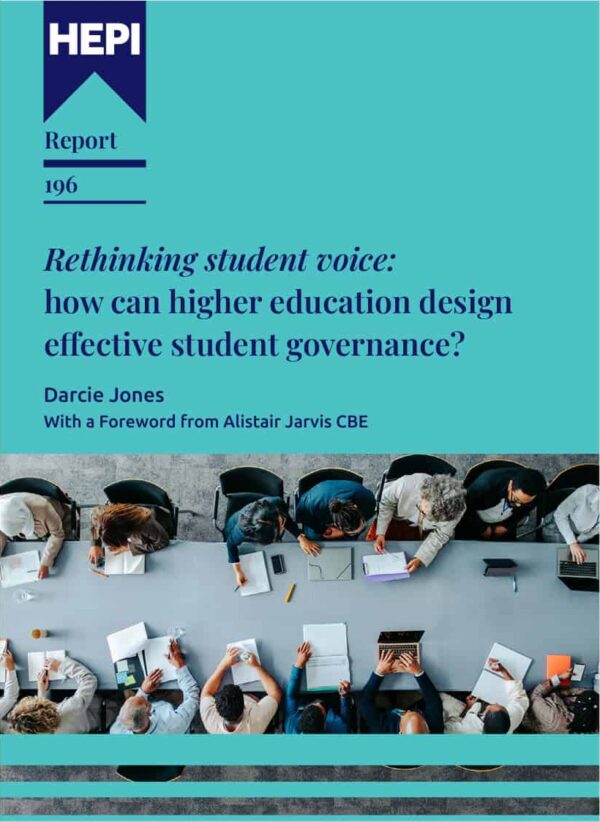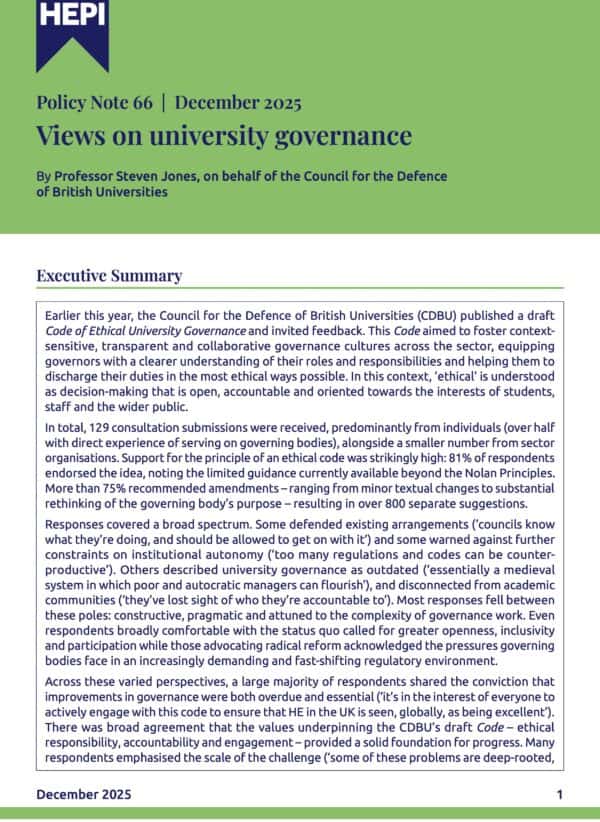Higher Education franchising is not the problem. Rogue providers and regulatory gaps are
By Charlie Tennant, Vice Principal at the London School of Science & Technology.
Higher education franchising is once more in the limelight for the wrong reasons, as many in the sector again question its benefits, the risks it poses to public funds and the use of it by niche, emerging and/or for-profit higher education providers. However, the stories and discourse miss the key factors that have allowed for abuse of the franchise model. It is gaps in higher education regulation that have led to franchising being scapegoated for what is, at its core, abuse by rogue providers that do not represent the vast majority of those engaged in franchising.
Franchising is a model through which UK universities have delivered higher education for over two decades. Internationally, this forms part of many forms of Transnational Education (TNE), that as seen in Universities UK International (UUKi)’s Scale of UK Higher Education Transnational Education reports, continues to grow in scale. Locally, providers have adopted the franchise model since the mid-2000s, although since then, the market for many of those providers has changed from international students to local students. This change meant the number of students at these providers who were eligible for Student Loans Company (SLC) funding has grown. The model allows institutions that have found new approaches, differentiated courses, or cold spots of higher education to develop and expand their provision, with a significant portion of them hoping to one day gain their own Degree Awarding Powers (DAPs).
However, the regulation of domestic franchise provision has not been as robust as it could be. The onus has rightly been put on the universities that are franchising their courses to ensure academic quality and standards of the franchise delivery, although there is currently no direct regulation of higher education franchise providers. Therefore, while some blame can be apportioned to universities engaged in franchising, it can be argued that the Department for Education (DfE) and policymakers’ approach to regulating higher education franchises has led to gaps open to abuse by rogue providers. Furthermore, routes for franchise providers to gain DAPs have been prolonged and made complex by the pause in processing of registration applications by the Office for Students (OfS). Now, the abuse of SLC funding by particular providers of the franchise model, reported by the Sunday Times in an article on 22nd March 2025 and in several articles since then, has brought the reputation of all franchise providers into disrepute, and connected the abuse to use of recruitment agents and the settled Romanian population in the UK.
In a January 2025 press release for their consultation on franchise provision regulations, the Government outlined the benefits of franchising when done right, and its intention to crack down on rogue higher education providers. Professor Nick Braisby’s HEPI blog published in response to the consultation, rightly welcomes the Government’s new proposals, but asks for the sector to remain critical. This blog therefore proposes three ways in which to ensure the Government and the OfS achieve what they hope to through the crackdown.
Firstly, the DfE, policymakers and the OfS need to enable quicker routes for franchise providers to join the regulator’s Register. This will allow greater scrutiny at an earlier stage in the lifecycle of an emerging higher education provider (which make up the majority of providers delivering franchised courses) and introduce a focus on their governance structures. Since the set-up of the OfS Register, providers have experienced long lead times for joining the Register, and on top of this, from December 2024, the regulator paused applications for the Register, DAPs and changes of registration category, thus exacerbating the issue of missing opportunities to directly regulate more franchise providers. This is counterintuitive given the OfS’s remarks around the risks associated with an over-reliance by both universities and franchise providers on partnership provision in their Insight Brief regarding subcontractual arrangements in higher education published just two months prior to the pause. The OfS’ Register of providers has the potential to be a great tool for transparency, but the current lead times and design of the approach lead to gaps in regulation that can be exploited by rogue providers.
Secondly, instead of considering an outright ban, the DfE should implement a robust quality framework for domestic student recruitment agents. As a blueprint, they should draw from the established Agent Quality Framework (AQF) developed by the British Council, Universities UK International (UUKi), and the UK Council for International Student Affairs (UKCISA). As with international student recruitment, the unregulated use of agents for domestic recruitment presents significant risks. By adopting a structured quality framework, the DfE and OfS can mitigate these risks and foster greater transparency and accountability. Agents, when operating under clear ethical guidelines and quality standards, can play a crucial role in widening participation, particularly by reaching communities historically underserved by traditional university outreach, for example, the UK’s settled Romanian population. A tailored framework can help to ensure transparency, effective governance and the establishment of professional standards of agents.
Finally, the DfE, policymakers and the OfS need to engage more with franchise providers and their university partners jointly. So far, engagements have been disjointed, with either a university or one of their partner franchise providers engaged separately. This creates barriers to collaboration, which would otherwise aid in the pursuit of greater transparency, oversight and the maintenance of academic quality and standards. Bringing both universities and franchise providers together when engaging will enable the Government to find ways to both demonstrate the benefits of franchise provision, as well as develop regulatory approaches and guidance collaboratively with stakeholders. This joint engagement with universities and their partner franchise provider could pave the early steps towards a sector-wide code of practice, an idea discussed in HEPI and Buckinghamshire New University’s Debate Paper on franchising. This could then sit alongside collaboratively developed regulations that would ensure rogue providers cannot abuse regulatory gaps. It will also help to establish a more balanced burden of regulation between universities and their franchise provider partners, and safeguard the reputation of franchise provision.
Ultimately, effective regulation of the broader higher education student journey, streamlined registration, and collaborative engagement are crucial. By addressing these systemic gaps and promoting transparency, the policymakers, DfE, OfS, and the higher education sector can restore faith in franchising and ensure its legitimate benefits are realised.







Comments
Ruth Arnold says:
Thanks for this article.
Very struck by your reference to cold spots. Policy makers should be reminded that many established universities began under the umbrella of another institution before they received their own Royal Charter.
Before colleges like Sheffield (where I worked for many years) became universities, they relied on the offer of an external London degree. Without it they wouldn’t have been able to provide higher education or attract able students and staff, all the time working with industrialists who helped fund their buildings and informed their academic ethos so the new institution offered courses relevant to local growth, such as metallurgy.
These pioneers were inspired by the Extension Movement to make available “the highest quality of education to the child of the working man”. There were extra-mural lectures in mining villages, training of teachers, and local engineers trained alongside the university’s first Chinese student who received a degree in metallurgy in the university’s first graduation ceremony. He went back to China where he helped establish his own country’s industry. A century later that same instinct to connect education, industrial research and wider participation led to the founding of an apprentice training centre in Rotherham next to the advanced manufacturing research centre, also with industry, and an inspiration to the founders of NMITE which has just had its own first graduation ceremony in Hereford.
Too easy to forget our own histories and assume a divide between different kinds of provision rather than think in terms of educational need and the students and communities that benefit from those willing to take steps beyond traditional boundaries and use other models to do it. I think government policy makers working on education and industrial strategy could do a lot worse than read the first chapter of Steel City Scholars by Helen Mather that tells Sheffield’s story, but which is not so dissimilar from HE across the country.
Reply
Jay says:
Frustration marked falsely as an analysis.
Utterly ridiculous article from a senior who should know better. Have you not read news on your own organisation Vice Principal?
The claim that most providers delivering franchised courses are new entrants is stated as fact but unsupported. There is no data or reference to substantiate the loud assertion. Critical policy commentary requires evidence and not generalisation (I’ve worked in policy for decades).
The argument criticises OfS for pausing registration while also acknowledging its concerns about over-reliance on partnerships??? But this contradiction isn’t resolved is he actually suggesting the OfS should allow more partnerships while simultaneously fearing them?
This royally fails to reconcile this tension resulting in a muddled critique.
Reply
Gavin Moodie says:
As this piece notes, failures of quality of educational franchises are very prominent and apparently persistent, and they erode confidence in all educational franchises and probably also in the franchisor overall.
So very robust measures are needed to restore the quality of and confidence in franchises. I am not convinced that a sufficiently robust regulatory regime would be designed by franchisors and franchisees some of whose members have been involved in failures of quality.of franchises.
Reply
Jasper says:
The article in question appears to oversimplify extensive historical context and disproportionately centres LSST as a primary exemplar of the franchise model. While LSST is indeed one of many institutions utilising franchised delivery, portraying it as emblematic of the entire framework is now reductive and misleading. Did you know The Times cites a 40% progression rate for LSST leaving in no post to offer solutions to others.
Broader press coverage has introduced a range of contradictory narratives regarding the effectiveness, ethicsand outcomes of the franchising model across the sector. Without a clear articulation of the metrics used, the structural nuances of franchise partnerships, or a comparative analysis of similar institutions, it remains unclear what exactly is being positioned as the “model” here. Is it LSST’s operational structure, student recruitment strategies, academic outcomes, or its relationship with awarding universities?
In its current form, the article risks conflating one institution’s experience with an entire sector-wide model.
Furthermore franchising within higher education is by no means a novel phenomenon. Its roots can be traced back several decades long before the emergence of more recent institutions.
Reply
Shahnaz says:
The LSST progression data published in the Times article does not accurately reflect the full scope of LSST outcomes. It is important to note that, within the sector, there is typically a few-year lag before the OFS publishes official data. As a result, the LSST progression data in the article does not include franchise progression rates. According to the OFS dashboard and website, franchise courses at LSST were only recently introduced, so the data published solely reflects the progression rates for non-franchise students.
Unfortunately, these critical details were not included in the article, likely to attract higher viewership with more attention-grabbing headlines. I always advise conducting your own research rather than accepting everything at face value.
Reply
Pete says:
Fraud and misuse of public funds in franchised provision is not about “rogue providers” – it is endemic in the system, costing hundreds of millions of pounds per year and will not be stopped just by forcing franchised providers to join the OfS register (lead providers are already on the register, several large franchised providers with suspect registration patterns also are).
And it is extremely naive to suggest that the staggeringly high participation rates in franchised business and management courses by the UK’s settled Romanian population is a positive thing rather than an indicator of a huge scandal that still has some distance left to run before everything is out in the open.
Reply
Add comment